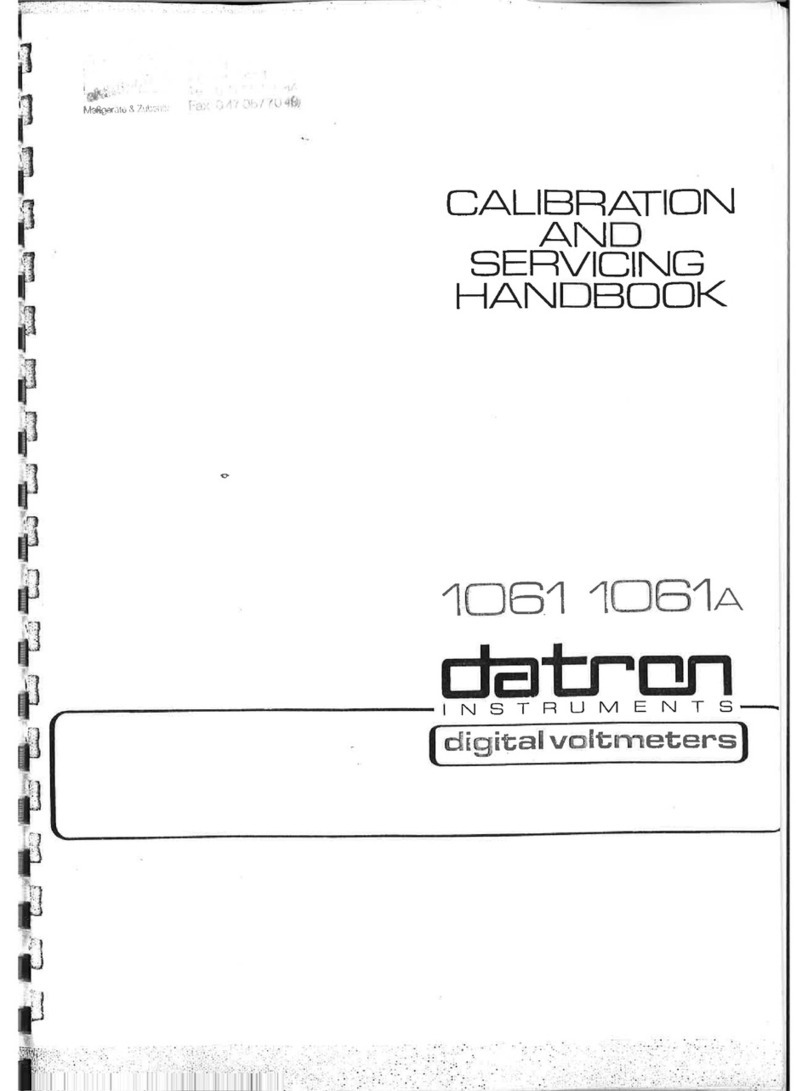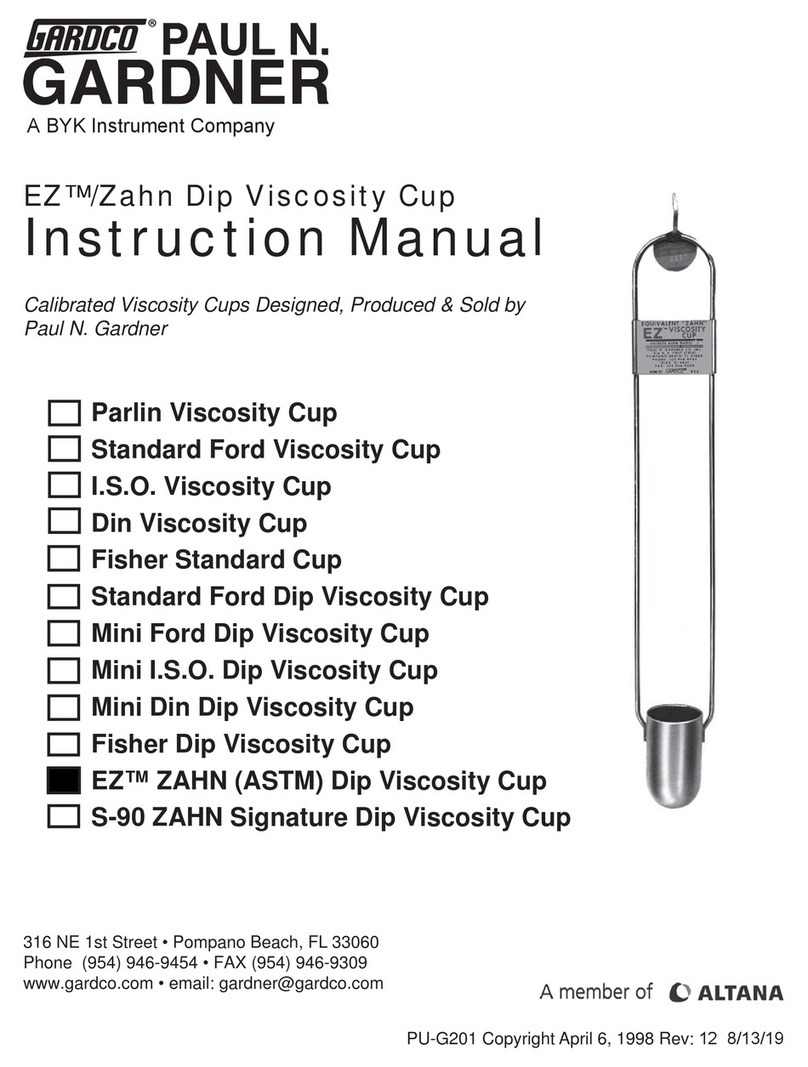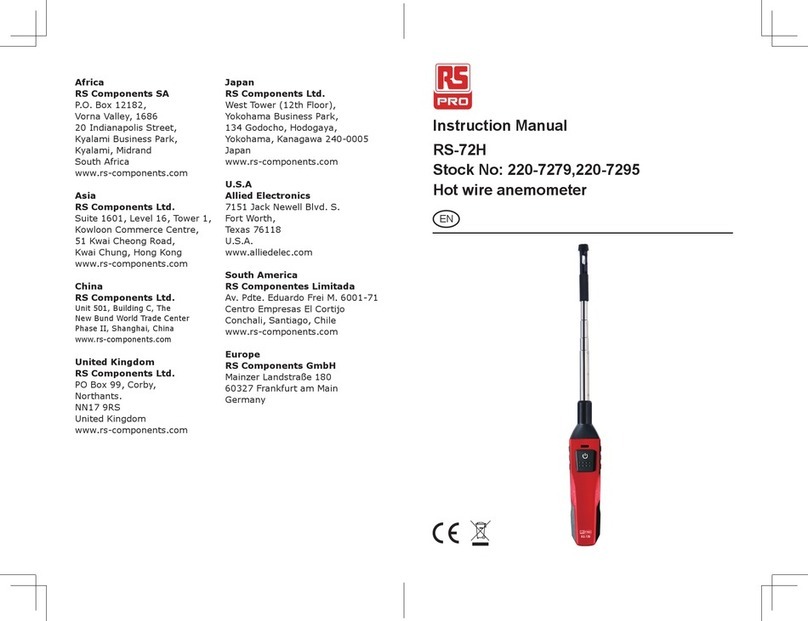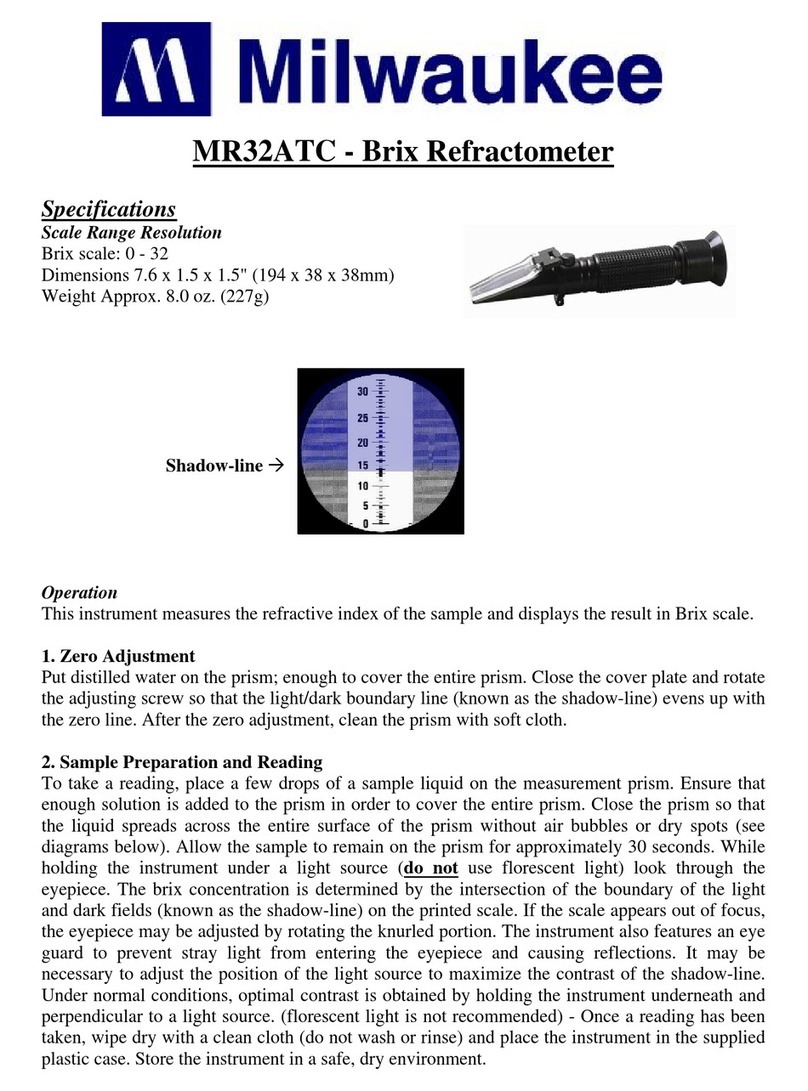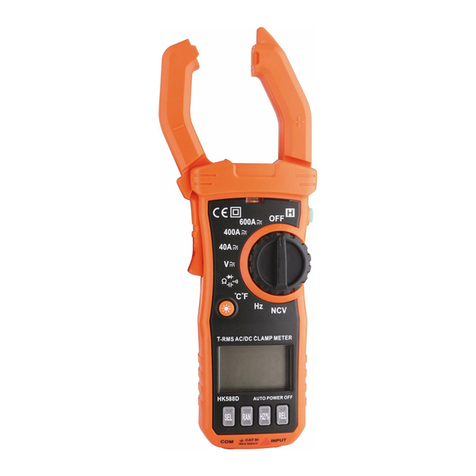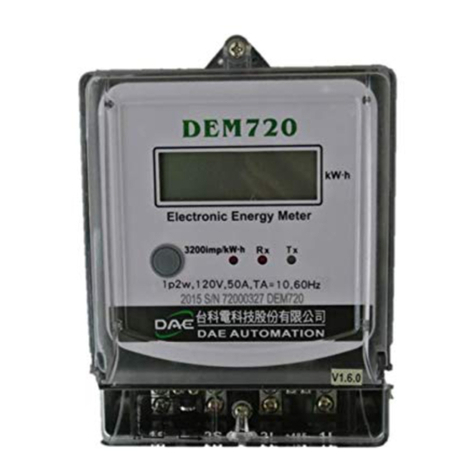Datron 1081 Instruction Manual

USER'S
.
HANDBD
□
K
·
·
1081
datr1
1
1I
_.-------INSTRUMENTs---
(
digital
multimeter
)

USER'S HANDBOOK
for
THE
DATRON
AUTOCAL
1081
DIGITAL
MULTIMETER
{for
maintenance procedures
refer
to
the Calibration and Servicing Handbook)
850042 Issue 2(February
1984)
For any assistance contact your nearest Datron
Sales
and Service Center.
Addresses can be found
at
the back
of
this handbook.
Due
to
our
po
icy o con I u · . .
design
to
the 1nstrumen
c1c
u ·
I
. f t·n ally updating our products this handbook may contain minor differences in specification, components and circuit
. . t . t ally supplied Amendment sheets precisely matched to your instrument serial number are available on request.
1984
Darron
Instruments
r
r

I
I
l
J
CONTENTS
SECTION 1 THE
1081
AUTOCALSTANDARDSMULTIMETER
Standard
and
optionalmeasurement facilities
Accessories
Principles
of
operation
SECTION2 BASIC MEASUREMENT
PROCEDURES
Maximum
input
voltages
Safety
Controls
DC
voltagemeasurement procedure
AC
voltagemeasurementprocedure
Resistancemeasurementprocedure
Rear signal input
Display messages
SECTION3 ADVANCED
OPERATIONAL
PROCEDURES
Externaltriggers
and
'Hold'
Rearinputs
Ratiomeasurement procedure
Selftest
Specmode
Platinum
resistancethermometermeasurements
Resistancedisplay
'Hi
Res' modemeasurements
Computation
facility
Load/reset
store
(A-B)
..,.c
Max
andMin
Limits
Recall memory
SECTION
4
SYSTEMS
APPLICATION
VIA
THE
IEEE
INTERFACE
Connectingthe
1081
intoa system
Addressselection
Usingthe
1081
inasystem
Programminginstructions
Control
of
OMM
inputs
Control
of
OMM
outputs
Servicerequest
ParallelPoll
Control
of
computingfunctions
Calibrationviathebus
Specreadout, test and
in~ut_
zero
Programstring
character_1st1~s
Operationalsequence guidelines
l~
Page
1-1
1-1
1-2
1-3
2-1
2-1
2-2
2-2
2-4
2-5
2-6
2-8
2-9
3-1
3-1
3-2
3-3
3-4
3-5
3-6
3-7
3-8
3-10
3-10
3-11
3-11
3-13
3-14
3-15
4-1
4-3
4-4
4-4
4-5
4-5
4-6
4-6
4-7
4-8
4-8
4-9
4-9
4-10

SECTION5 INSTALLATION
Unpacking
and
inspection
Preparationfor operation
Connectors
and
pindesignations
SECTION6 SPECIFICATIONS
General
DC
Voltage
AC
Voltage
Resistance
Temperature
Ratio
and
"fransfer
Standard Internal delays
SECTION7 SPECIFICATIONVERIFICATION
Introduction
Equipmentrequirements
Verificationprocedures
Specificationverification report
S-J
S-
J
S-1
S-2
6-1
6-J
6-2
6-4
6-6
6-
8
6-9
6-10
7-1
7
-1
7-1
7
-3
7
-4

l
,J
,J
l~
J
SECTION 1 THE
1081
AUTOCAL STANDARDS MULTIMETER
The
Datron
1081
6½/7½
digit AUTOCAL
STANDARDS microprocessor-controlled digital
~ultimeter
(DMM) is a high precision measuring
instrument.
It features exceptionally high stability
and
systems capability.
The
instrument provides
full measurement capability, computation facil-
ities,
self
check routines
and
calibration memory.
Standard
and
optional
measurement
facilities
The
instrument
is offered in two versions, either
complete
with all options
or
as
a basic
DC
voltage
instrument
to
which individual options can be
added
to
provide
further
measurements:
Resistance (including temperature)
True
RMS
AC
voltage
DC
coupled
true
RMS
AC
voltage
Ratio
o/o,
/J.,
/J._o/o
The
full
range
of
options
is
as follows:
Option
JO:
True
RMS
AC
Converter
Option
20:
4-Wire Resistance Converter
·
Option
40: Selectable Rear/Reference Input
Option
50:
IEEE
488-1978
Standard
Digital
Interface
Option
52:
Remote
Trigger
Option
70:
Analog
Output
Calibration
TheAUTOCAL instruments have been designed
to
make the removal
of
the covers for calibration
unnecessary, as full calibration_
of
all ranges
and
functions can be carried
out
from the front panel.
Theprocedure for calibrating
the
instrument
is
con-
tained
in
the Calibration
and
Servicing
Handbook.
Accidental
or
unauthorised use
of
the calibration
routine
is
prevented by a key operatedswitch
on
the
instrument rear panel.
Message read-out
The measurement display doubles as a message
display, providing a clear read-out
of
14
different
messages. Full details
of
the meanings
of
these
displays can be found in sections 2
and
3.
Self test
Pressing the '-+' then
'Test'
key starts a
self
test
procedure, during which a sequential routine:
-checks, in
turn,
all the display segments, char-
acters and legends
-verifies the correct functioning
of
individual
measuring circuits
-checks the
non
-volatile calibration
memory
Option
80: 115V 60Hz Line
Operation
Option
81: 115V
50Hz
Line
Operation
Option
82: 115V 400Hz Line
Operation
Option
90:
Rack
Mounting
Kit
On
completion
of
the test, theinstrument re
turn
s
to
thelast selected function
and
range to provide
rapid
return
to
measurement. In the event
of
the self test
failing, an
error
message
is
displayed.
1-1

Computing
The range and function selection
keys
double
as
a
keyboard for the input
of
data
so
that measure-
ments can
be
compared
with
previously recorded
data or manually input data
for
display of:
-measurement offset
-percentage deviation
-maximum and minimum value storage
-the exceeding
of
limits (upper and
lower)
Full details
of
these facilities are
given
in
section
3.
Systems
use
The AUTOCAL
1081
instrument
can
form
part
of
a system
by
means ofthe IEEE
488
standard digital
interface option. The details
for
the connections of
the instrument to the
system
and
programming
details for the controlling machine
can
be
found
in
section 4.
1-2
Accessories
The instrument
is
supplied
with
the
f
II
0
OWin
g
accessories:
Description
Power cable
Hexagon
key
2mm
A/F
Hexagon
key
2.5mm
A/F
Set
of
calibration
keys
User's Handbook
Calibration and Servicing Handbook
Power
fuse
(230V)
or Power
fuse
(1
I
5V)
Part
Nurnber
920012
630101
630109
7CXXJ68
850042
850048
920()24
920084
In
addition, the following accessories
are
available
for
use
with
the
1081
instrument:
Pan
Description
HVP
high
voltage probe
RMK
rack mounting kit (option
90)
1501
de
luxe
lead kit
PRT
100:
Platinum resistance
thermometer probe (I
OOfl)
Additional documentation
Number
400335
440063
440070
630161
The Calibration and Servicing Handbook
contains
information required to adjust and
service
the
DMM.
It
contains detailed description
of
the
circuits, trouble shooting diagrams,
calibration
procedures, parts lists and circuit
diagrams
.

I
l
i
1
i
Principles of operation
-------
-~-
-
--
---
.
~~
------------
-~~
-
--
-1 INTl•ACI
""""'
"'••
] l
~
'<>-
n
-+-+--___J
I
_ , - -'------0
'-o--
DC I
- I ISOLATOR I
- I I
-= I
"-NEL
- \
]
I ~
~-
.-c-
---+-~---~
'"""
~
I
-]
I
"""•
= I
,_
'
"""'
=~'<>-
- I
I
I
I
I
I
DCJA
C
7
AC
CONVlflTOfl
ANM.00
TO
..,.,.,.
COIMOTOO
i.-----+---j
To
heh
·-
-
1- -
-----
--
- - -
---
--
- - -
--
------
- -
-~~o_\
OUTGUAAO
Fig. 1.1
DMM
simplified block diagram
Figure
1.1
shows
how
the
DMM
achieves
its
basic
measurement functions,
its
advanced measurement
and computing functions and the interfacing
with
other equipment
in
systems applications.
Voltage
measurement
The instrument comprises a
fully
floating isolation
amplifier with electronically
switched
gain
ranges
providing a
full
range output
which
is
applied
to
the
analog to digital converter.
AC
voltage
measure-
ment
is
achieved
using
a True
RMS
AC
converter
which converts
AC
signals
to
DC
and
applies
the
DC
voltage to the analog-to-digital converter.
Resistance measurement
Resistance measurement
is
achieved
by
passing
the
current from
an
internal precision current
source
through the unknown resistance and
sensing
the
voltage developed across the resistance.
Temperature measurement
Temperature measurement
is
achieved
by
passing
current from
an
internal precision current
source
through a platinum resistance thermometer (PRT)
probe and
sensing
the voltage developed
across
the
probe. This
is
converted digitally
and
then
dis-
played
in
°C (PRT),
or
Q
(kQ
PRT)
.
Analog to digital conversion
The
signal
from
the
DC
isolator or
AC
converter
is
applied
to
the input of a
high
gain integration
amplifier.The integration capacitor starts charging
from
a
zero
state at a rate proportional
to
the
magnitude ofthe incoming signal. The integration
period
is
approximately
160mS
.
.....
,
INTIOIIA
TIOfllll
MflflllNCl
wnOIIAHON
Fig.
1.2 Simplified measurement cycle
At
the
end
of this period, a reference
signal
of
opposite polarity
to
the input
signal
is
applied
and
the
time
taken
for
the
capacitor
to
discharge
to
zero
volts
is
measured
(null
detection), providing
an
accurate computation of
the
input
signal
mag-
nitude.
1-3


J
J
1
I
I
I
1J
SECTION
2
BASIC
MEASUREMENT
PROCEDURES
Preliminaries
Before
using the instrument it is important that it
has
been correctly installed as detailed in section
5.
Maximum
input voltages
The
following tables give the maximum input
voltages
to
the DMM (front panel) for each
of
the
operating
ranges.
~or
rear
panel
and
ratio inputs, maximum inputs
indicated
at
1000
or
650V RMS must be reduced to
250V
RMS
.
The
&symbolis used
to
remind the user
of
special
precautions detailed in his Handbook
and
is
placed
adjacent
to
terminals
and
switches thataresensitive
to
overvoltage conditions.
NOTES:
a)
With the local
1,!Uard
, remote guard ,witch
,ct
to •f.,K
al
(iuard'.
this value reduces
to
0V
. i.e. the terminals arc intcrnJlly lin~cd.
b) Values specified a
,,
umc peak l'oltagc
~
RMS ,oltagc x
rT
Also. maximum rnpu1, ol
IO00
nr
(,50V
RMS rcdun· to
250V
RMS
for rear
and
ratio rnpu1,.
Maximum permissible voltage between Iron! and rear input, i,
equal to the maximum input at the front input fnot ,witched)
or
250V
RMS
(switched).
c) Logic Grounds for remote interfaces are internally connected to
Safety
Ground
.
d) When the 2-wirc
fl
/4-wire
.Q
switch
is
set to "2-wirc
.Q
'.
the
·1+· terminal is internally linked to the 'Hi' terminaland the 'I ·
terminal
is
internally linked to the
'Lo'
terminal.
el Maximum slew-rate
of
'Guard'
with respect to Safety Ground
or
Logic
Ground~50V
/uS
(5
x
10
1 volt Hz) for normal operation
(accuracy
is
degraded as volt Hz product increases).
f)
Maximum slew-rate
of
any terminal
10
Safety Ground should be
~
lkV/
uS
(10' volt Hz) or the instrument may revert to the
'power up' condition
(i
.e. select
DC
I000V range).
H,
.---
l ,
OOOV
lo
2sov
f
df
1
,llOOV
,·
l ,
OOOV
2sovldl
l ,
OOOV
1.000V 250V
,,
I l ,
OOOV
I.
OOOV
ov
l ,
OOOV
l ,
OOOV
6SOV
I.
OOOV
1.
000V
650V
I 000V
I
2SOV
250V
6SOV
650V
DC& A
CVI
o tage
GUARD
2sov
1
•1
ssov
l
•I
550vl•
I
!l',
GUARD
6SOV
SAFITY
GROUND
LOGIC
GROUND
·
650V 0V J
Table
2.1
Maximum
RMS
inputvoltages [bl
H,
....-
i~ov
'"
2sovldl 250V I
250V
2sov
l
ul
250V
250V 250V 250V
250V 250V 250V
I.
OOO
V
6SO
V I.
OOOV
I.
OOO
V 650V l.()O()V
I
250V
GUARD
25
0V
2r,ovl•I
650V
ssovl•I
650V
sso
vl•I
Resistance
l!',
GUARD
6SOV
SAFET
Y
6
50V
ov
I
GROUND
LOGIC
GROUND
Table 2.2
Maximum
RMS
inputvoltages
[bl
2-1

-
Safety
The
1081
Multimeter
is
designed to
be
Class
I
equipment
as
defined
in
IEC
Publication
348
and
UL
1244
concerning safety requirements. Pro-
tection
is
assured
by
a
direct
connection v
ia
the
power cable from ground to exposed metal parts
and internal ground screens.
The
line
connection
must
only
be
inserted
in
a
socket outlet provided
with
a protective ground
contact and continuity
of
the ground conductor
must
be
assured
between
the socket and the
instrument.
WARNING:
ANY
INTERRUPTION OF THE
PROTECTIVE
GROUND CONDUCTOR
INSIDE
OR
OUTSIDE
Controls
Fig.
2.1
Front panel
·Line
on/
off
('Power') switch
When
set
to the
Off
position,
this
switch
isolates
the
instrument from the
line
supply.
When
switched
to
the
On
position, the instrument
powers
up
and
automatically selects
its
DC
IOOOV
range
.
After ½ hour, the instrument
is
near to
its
full
specification, but should
be
left
on
for
2 hours
before
use
if
full
accuracy
is
required.
Function keys
The four
keys
'PRT', 'kfl', 'AC' and 'DC' -
provide the means to
select
the
mode
of
operation
of
the instrument and contain
LED
indicators that
light to show the
selected
function.
'Zero'. This facility
is
available
on
all
DC
voltage
and Ohms ranges,
by
manual or
systems
operation.
2-2
THE INSTRUMENT OR DISCONNECTION
OF
THE PROTECTIVE GROUND
TERMINAL
MA
y
MAKE
THE APPARATUS DANGERous.
INTENTIONAL INTERRUPTION
IS
PRO-
HIBITED.
THE TERMINALS MARKED WITH
THE
t,
SYMBOL
CARRY
THE POTENTIAL
OF
THE
SOURCE
UNDER
TEST
. THESE
TERMINALS AND
ANY
OTHER
CONNECT-
IONS
TO
THE SOURCE COULD
CARRY
LETHAL
VOLTAGES.
AT
NO
TIME
SHOULD
THESE
CONDUCTORS
BE TOUCHED
DURING
A TEST OF HIGH
VOLTAGES.
IF
DIFFICULTY
IS
FOUND WITH THE
TEST
,
ENSURE
THAT THE SOURCE
IS
RENDERED
SAFE
BEFORE ATTEMPTING TO
IMPROVE
CONNECTIONS.
When
the 'Zero'
key
is
pressed, the
DMM
a)
accepts the measured input
as
a zero
offset
for
the range selected, providing
it
does
not
exceed
approx
l.50/o
of
full
range.
b)
stores the offset value
in
non-volatile
memory
.
c)
compensates ALL SUBSEQUENT
READINGS
taken on that
range
by
the stored off
set
value
,
until the user redefines the zero.
If the measured input offset exceeds
1.50/o
of
full
range from the calibrated
DMM
zero,
no
offset
is
stored and the Error 4 message
is
displayed
.
Aseparate zero
off
set correction
is
stored
for
each
range. When the
DMM
is
in
'Auto' during
the
Zero
routine, all ranges are zeroed automatically
in
ascending order.
,.

J
1
J
l
]
l
-=
]
]
CAUTION
The stored off
set
correction
is
applied
to
all
readings,
so
that the correct procedure
is
to
re-zero
the
DMM
whenever the input zero condition
is
changed. Failure to observe this procedure
will
cause an incorrect zero compensation to
be
applied.
'Filter'
key.
The 'Filter'
key
is
pressed to increase
the normal mode
AC
noise rejection
in
measure-
ment
of
DC
volts, PRT or resistance.
In
Filter
mode, a block average of 4
is
set.
AC
Filter
keys.
The
AC
Filter
keys
extend the
low
frequency response ofthe instrument
to
10Hz, 1
Hz
or 0.lHz.
Range select keys
The instrument range of inputs
in
each
function
is
as
follows:
lOnV
-1,000VDC
.lµV -
l,OOOV
true
RMS
AC
1µ!2
-
20M!2
Fig. 2.2 Rear panel
Calibration enable keyswitch
The calibration procedure
is
detailed
in
the
Calibration and Servicing Handbook. The
calibration
switch
is
of the locking
type
to
avoid
accidental or unauthorised initiation of
the
calibration procedure.
Autorange ('Auto')
key.
This
key
commands the
instrument
to
select
the optimum ranges
for
the
measurement, saving the operator this task and
introducing
very
little delay.
Mode
and compute keys
The function
of
these
keys
is
given
in
Section 3.
4 wire/2 wire switch
During resistance measurements, this switch should
be
set
to
match the connection arrangement.
Local/remote guard switch
Selection of'Local Guard' connects the front panel
'Guard' internally
to
the front panel
'Lo'
terminal
for
voltage measurements, and to the front panel
'!2
Guard' terminal for resistance measurement.
Selection
of 'Remote Guard' isolates the 'Guard'
terminal
from
all
others and enables a remote
connection
to
be
made from the internal guard
screens
to
the
source ofany common mode voltage.
©
Calibration interval switch
The
calibration interval switch should
be
set
to
correspond
with
the intervals that elapse between
re-calibrations of the
DMM.
The setting
of
the
switch
determines the selection of specification
values
displayed
when
the ,.,.., then 'Spec'
key
is
pressed
(see
Section 3 -
Spec
mode).
2-3

DC
voltage measurement procedure
6½
digits
4
Connect
guard
if
remote
guard
■
elected
2 Select RANGE
--
- -
AANGE-----..
FUN
CT
I
ON
5
Apply
signal
to
'Hi'
and
'Lo'
terminals
3 Select 'Filter'
if
required 1 Select 'DC'
Simple lead connection
For the majority
of
applications
the
simple
lead
connection shown
below
with
'Local Guard'
selected
will
be
adequate.
The
disadvantage of
this
simple arrangement
is
that the connecting
leads
form a loop. If a stray alternating
magnetic
field,
e.g. from the line transformer of a neighbouring
instrument, passes through the loop
it
will
behave
as
a single turn secondary
winding
inducing
unwanted
AC
voltages into the measuring circuit.
Use
of
a twisted pair
will
reduce
the
loop area
as
adjacent twists
will
automatically
cancel
any
induced voltages. If problems
with
stray pick-up
are encountered,
it
is
recommended that a
screened
twisted pair cable
be
used
with
the
screen
connected
to the
'Lo'
or 'Guard' terminal.
Hi
··
--i
(Local r
---
--I
Guanll~
Use of remote guard connection
The 'Guard' terminal should
be
used
with
'Remote
Guard' selected
when
the source to
be
measured
presents an unbalanced impedance
to
the
measur-
ing terminals and common
mode
voltages are
present. Regardless of
how
the 'Hi' and 'Lo'
terminals are connected, the 'Guard' terminal
should refer to the source of common
mode
voltage.
This
will
ensure that errors,
caused
by
2-4
common mode currents flowing
in
the
measuring
circuits, are minimised
by
providing a
separate
common mode current path
as
shown
in
the
examples
below.
Rl, Cl
R2,C2
CASE
~AO-
- - -,
Hi
I C,
R,1
I
I
Lo
'++--~;;
I
------
I
C2
R2
~t1
-
~---L__
----;Vcm,L--~
2
= Input impedance
R3,
C3
Vcml,
Vcm2
= Input to guard
leakage
impedance
= Guard to
case
leakage
impedance
= Common mode
voltages

AC
voltage measurement procedure
5½
digits
~
4 Connect guard,
if
remote guard
selected 2 Select RANGE
RANGE
l+
I
~
(j
l\
rd
4w~~n
2w11'1!n
1§11~~13~
LOC.ftl
Gulrd
I!
Re-
Guard
>
o , 2 3 4 5 6
7<
KEY(IIIO,\RD
------c"
Er:J=i
~
•-CINrMt•PV
~
u .....
Zuo
Fi
tl1r
,n
IOHI IHI.
•IHt
FUNCTION
5 Apply signal
to
'Hi' and 'Lo' Select 1 Select AC
10Hz/1Hz/.1Hz
terminals if required
Low
frequency measurements
To
measureanysignal
of
frequency below
IOOHz
to
full accuracy, DC coupling MUST be selected
as
shown
below. Selection
of
I
OHz,
IHz or
0.1
Hz
filter, increases the settling time as shown in Section
6 - Specifications.
DC
coupled AC voltage measurement procedure 5½ digits
I+
4 Connect guard,
if remote guard
selected 2 Select RANGE
4wuen
el
2w
1
ren
LCX"I
Gulrd
I!
Remote
Guard
RANGE
1111~1!i!i~
>
o 1 2 3 4 5 6
7<
a 9 •
KE
IRo
...
-_-c-,..-,-M,-<
..
~
□
l,a
........
--
Ztro
Fithr
,n
kn
fOHI
IM
z •I
Ht
FUNCTION--......+../
--+
Tnl
s,..c
.,
.....
~old ~i\
-•f
/;
RGbo
NIIII
~'MODE~
5 Apply signal
to
'
Hi'
and 'Lo'
terminals
3 Select
10Hz/1Hz/.1Hz
if required
1 Select
AC
and
DC
keys simultaneously
AC
voltage measurement
Whilst for DC voltage measurement the resistance
of
the connection lead
is
generally unimportant so
long as it
is
small compared with the input
impedance
of
the measuring device, with AC
voltage measurement the capacitance may give rise
to
an
appreciable shunting effect causing source
loading as well as voltage drop in the leads. The
approximate
'Hi'
to
'Lo
' capacitance
of
the leads
in
the
Datron lead kit are:
low thermal-emf lead with spade
terminals-65pf,
otherleads-160pf.
In extreme cases, use
of
separate leads
will
give
lower capacitance (dependent upon spacing but
typically
4pf)
but
will
be liable to corrupt the
measurement
by
adding induced signals. The table
below gives the approximate impedances at differ-
ent frequencies.
FREQUENCY
LEAD
CAPACITANCE
4pF
65pF
160pF
100Hz
400M.U
20M.U
10MO
1kHz
40MO
2Mf2
1Mf2
10kHz
4MO
200kf2
100kf2
100kHz
400kf2
20kf2
10kf2
1MHz
40kf2
2kf2
1k.U
Table 2.4
Connection
lead
capacitance
2-5

Resistance measurement procedure
1 Select '2-wire' or
'4-wire'
as
required
(see
below)
4 Select R~NGE
I+
I-
~
2 Connect resistance (see below)
RANGE
5 Select filter
if required
2-wire measurements
I•
(2-Woretl)
Ho
· .
nGuard
(Local
Guard)
Guard
3 Select kn
For the majority ofapplications,
the
simple
2-wire
arrangement
will
be
adequate.
However,
the
value
displayed
will
include
the
resistance
of
the
connect-
ing
leads.
Use
a
screened
twisted
pair
cable
to
reduce
induced
voltages, particularly
where
Rx
is
high.
2-6
t!l~]~~
(A-Sl
-'-
C Ma,c Mon
~t
\
ual
ci,u,..
rre
ac
"'.l,H'J
'--COMPUTE~
4-wire measurements
I+
Hi
'
------
-
--
-
----,-,.,
I-
'
~---
-
--
----
-
..
,
With
a
4-wire
connection
the
lead
resistances
have
negligible
effect
and
only
the
value
of
Rx
is
dis-
played.
The
4-wire
connection,
as
shown
above
using
two
screened
twisted
pair
cables,
is
also
suitable
for
measuring
high
resistances
with
long
cables
since
the
effects of
leakage
and
capacitance
between
leads
is
eliminated.
When
making
very
high
resistance
measurements
the
'il
Guard'
terminal
should
also
be
connected
to
a
guard
screen
wrapped
around
the
resistor,
or
the
case
it
is
mounted
in,
to
reduce
any
errors
due
to
noise
.

True 4-wire zero
For accurate measurements of
Ohms
it
is
ESSENTIAL that a correctly connected
zero
source
is
used
when
operating 'Input zero' before
making a
series
of resistance measurements.
Two
arrangements
are
shown
below,
depending
upon the resistance to
be
measured,
which
ensure
that thermal emf effects
are
eliminated.
(Local
Guard) -
Less than 10k.Q
I+
-----------,-
,
Hi
v---
,
:-,t-------___;.......,i..~
----
-----
--'-
"
Guard
.Q
Guard
- - - - - - - - - - - --
Lo
O-
........
-':----------....;.
'
__:
'
I-
Fig. 2.1 Zero resistance source connections
'In-circuit' measurements
•n
Guard' can
be
used
to
make
'in-circuit'
resist-
ance measurements
by
guarding out parallel
resist-
ance paths
so
that
only
the
value
of
Rx
will
be
displayed.
Similarly,
•n
Guard'
can
be
used
to
reduce
the
settling
time
if
Rx
is
shunted
by
any
capacitance
and
a suitable tapping point
is
available.
Providing that
Ra
and
Rb
are
no
less
than
250Q
(l
.5kQ
on
lOOOkQ
or
lOMQ
Ranges),
and
the
Q Guard resistance
(Rg)
is
less
than
5Q;
the
actual
value
Rx
can
be
calculated
from
the
displayed
value
Rd
by:
Rx=Rdx(I
+E).
Deviation fraction 'E'
can
be
found
within
I
11/o
by
the
simplified formula:
E
(Rd
.
Rg)
,
(Ra.Rb)
(Local _
Guard)
10k
!1
or
greater
It ,
--
- - - - - - - - - - -
-7,
Guard
.Q
Guard
Copper
Shorting
link
----------
, -
I-
.....,_
----------__
..,,,
(Where
Rg
is
the
QGuard lead-resistance from
the
junctio~ of
Ra
and
Rb,+0.25Q.)
Example:
If Rd=
lOOQ,
Rg
= IQ, Ra= Rb=
lOkQ,
then the
value
of E
is
given
by:
IOO
x I -
JO
-t.(l f d'
)·
E I
Ok
x I
Ok
-
ppm
o
rea
mg
'
The
value
of
Rx
is
thus
given
by:
Rx=
100.(1
+
10
-6) Ohms,
=
100.0001
Ohms
I•
h•Ia
--------
Ia
Hi
----
-
-~
'
Ix
Guard
lloc1I
Guard
I n
Gu1td
Ia
R1
Lo
I-
h -- -- -- --
~--
----,:
Ib
•O
Ra
Rb
2-7

Rear signal input
:he
measurement source
ma
y be
conn
ec
t
ed
to
th
e
REAR SIGNAL l/P'
plug
in
ste
ad
of
the
front
panel terminals
when
front
panel
'Rear
Sig'
is
selected.
For
all
rear panel inputs
the
ma
x
imum
limit
is
250V
RMS
. '
Wh ·
en
usmg
the rear
panel
input
plug
the
front
panel switches '4-wire n / 2
wire
Q'
and
'Local
Guard/Remote Guard'
are
inoperative. Therefore
a_connection
must
alwa
ys
be
made
to
the
'Guard'
pm
H and
for
2-wire
resi
s
tance
measurement
external connections
must
be
made
from
'Hi' to
'I+'
and
'Lo'
to 'I - '
Not used '--.... Hguard
l+-~~I
G""'
-------7•"
,L lep.ol
lo
Input Hi
Fig. 2.2 Rear
input
7 pin plug
2-8
Thermal EMF
Th
e
rmal
emf
s
are
significant
in
DC
voltage
and
current resistance
mea
surement
s,
es
pecially
when
mea
s
uring
tow
voltage
s
or
large
currents.
Th
es
e
unpredictable thermal emf
error~
arise
when
di
s
similar
metal
junctions
are
at
different
temp
.
cratures.
To
minimise
thermal emf errors use
the
s
ame
material throughout
the
measuring
circuit,
particularly
avoid
the
use
of s
teel
p~obes,
nickel
plated
terminals and tinned copper
wire.
The
table
below
shows
thermal emfs relative
to
hard
drawn
copper
at
23
°
C.
MATERIAL EMFµV!°C
SILVER
+0.03
GOLD
+0
.
01
TIN
-3
LEAD
-3
NICKEL
-22
If
dissimilar
metal
junctions are
used
ensure
that
they
are
offset
by
other junctions of
the
s
ame
material
at
the
same
temperature and
allow
for
thermal
emfs
by
making the measurement
twice
with
reversed
polarity.
A
lead
with
gold
plated copper
terminals
is
provided
in
the
Datron lead
kit
for
making
low
thermal
emf
connections.

_Display
messages
Alpha numeric messages
will
appear on the display
when
an
input, computational or memory error
occurs. A message
will
also appear
when
a limit
is
transgressed and during the self test routine.
Message
Error O L
Error I
Error 2
Error 3
Error 4
Error 5
Error 6
Error 7
Error 9
IP·O
FAIL
Hi Lt
Lo Lt
Err
Lt
PASS & Legend
Cont
Cause
Overload
199999(9)
Arithmetic Overflow
Invalid Data Entry/Recall
Spec>
100%
or unspecified
Zero or calibration input error
DC
Self Test failure
kn Self Test failure
AC Self Test failure
Arithmetic Underflow
Zero memory error
Calibration memory error
Hi
Limit transgressed
Lo
Limit transgressed
Hi
and
Lo
Limit transgressed
Self Test pass
message
}
Continuous Average mode selected
Correction
Reduce input signal or up range
Adjust C store, rear signal or
reference input
Adjust Data value/Recall
Adjust applied input and repress
key
Refer to Calibration & Servicing
Handbook
Adjust C store, rear signal or
reference input
Repeat input zero procedure
Ref
er
to Calibration &Servicing
Handbook
Amend
limit
values
2-9


i
J
SECTION
3
ADVANCED
OPERATIONAL
PROCEDURES
I
lJ
E
I
)
I
I
)
l
1
I
J
The
procedures for exercising the features that
~upplement the basic measurement functions
of
the
instrument
are detailed
in
this section.
External triggers and 'Hold'
In
RANGE
11~111~!a
>
o 1 2 3 4 5 6
7<
KE~RO----c.
I~~~
~
~
,~~~-
Zero
Fith,-
ll'lf
Jii..rt
~
DC
\.'""'
'"'
''"'
FUNCTION
1 )
When
the instrument
is
under local control,
readings are taken at a rate
in
accordance with its
internal read rate specification. When the
'Hold'
key
is
pressed the reading
in
progress
is
completed
and
displayed,
but
no
further readings are taken.
Digital
Common
(Logic
ground)
Not used
Trigger
/
(triggers on
_ high to low edge)
A \ '
" ' ,' Not used
D
\.,
/ Not used
Fig.
3.1
External trigger 5-pin plug
The DMM measurement cycle can be triggered
externally, after the internal trigger has been
disabled by pressing the
'Hold'
key.
The
trigger
occurs on a high to low edge.
The
external trigger
connector
is
on the rear panel, connection arrange-
ment
is
shown
in
Fig. 3.1.
If
'Hold'
and
'Auto'
are
both
selected, when
triggered, the instrument will change range as
required before a reading
is
taken
and
held.
Pressi11g
'Hold'
again returns the instrument
to
its
free running condition.
3-1

3-2
Rear inputs
The
two
rear input
plugs
REAR
SIGNAL,
and
REFERENCE
can
be
used
as
extra
signal
inputs
(250V
RMS
max)
by
simply
pressing
the
appro-
priate
key
on
the front panel.
When
using
rear inputs, Guard
is
remote
and
fl
Functions are connected
as
4
wire.
Select
or
'Sig'
Select
'Ref'
For
Local
Guard, connect 'Guard'
to
'Lo'
for
Voltage
functions and to
'fl
Guard'
for
n
Functions.
For 2
wire
n,
connect
'Hi'
to
'I+',
and
'Lo'
to
'I-'.
The
front 4 wire/2
wire
switch and
Local/Remote
Guard
switch
are inoperative
in
rear input
modes.
Table of contents
Other Datron Measuring Instrument manuals
Popular Measuring Instrument manuals by other brands
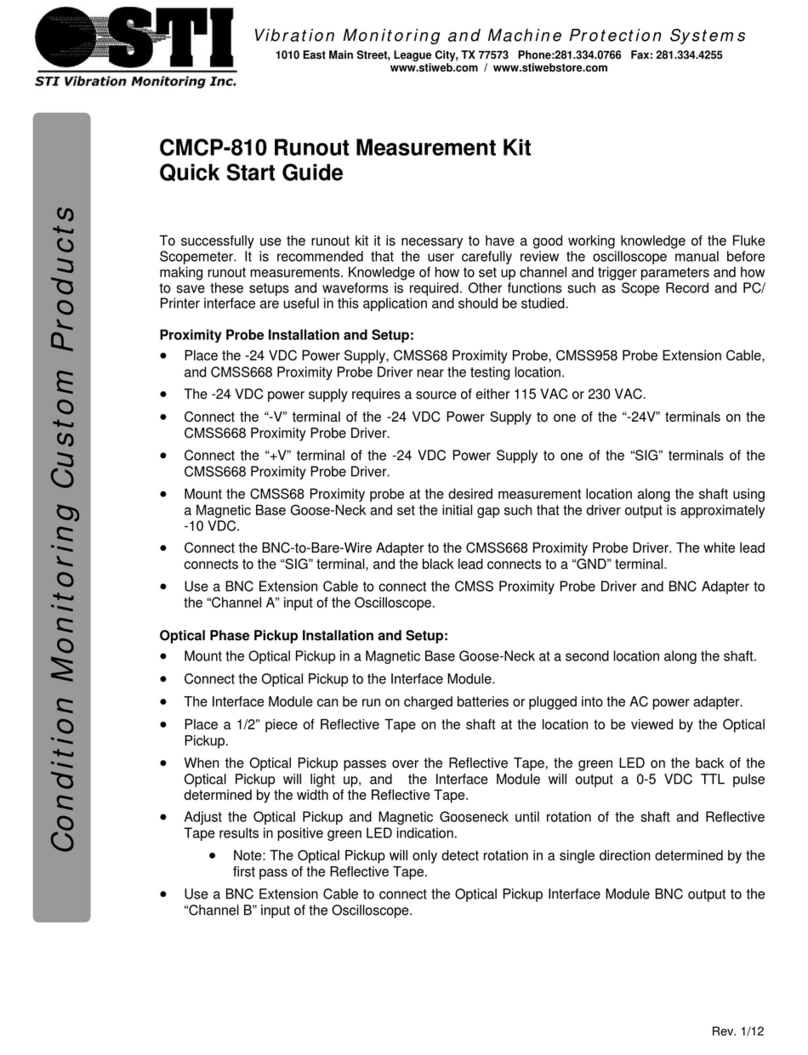
STI
STI CMCP810 Series quick start guide
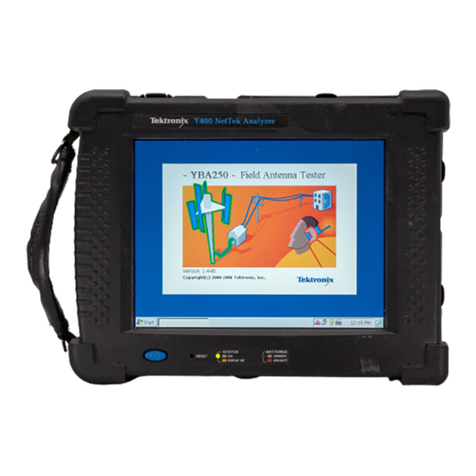
Tektronix
Tektronix NetTek Y400 Setup guide

Bushnell
Bushnell Bone Collector LBC1000 manual

S+S Regeltechnik
S+S Regeltechnik AERASGARD FSFTM-CO2-Modbus Series Operating Instructions, Mounting & Installation

CTC Union
CTC Union SB252 Series product manual

Tektronix
Tektronix PQA600C Software upgrade instructions

IFM Electronic
IFM Electronic efector 300 SL0106 installation instructions
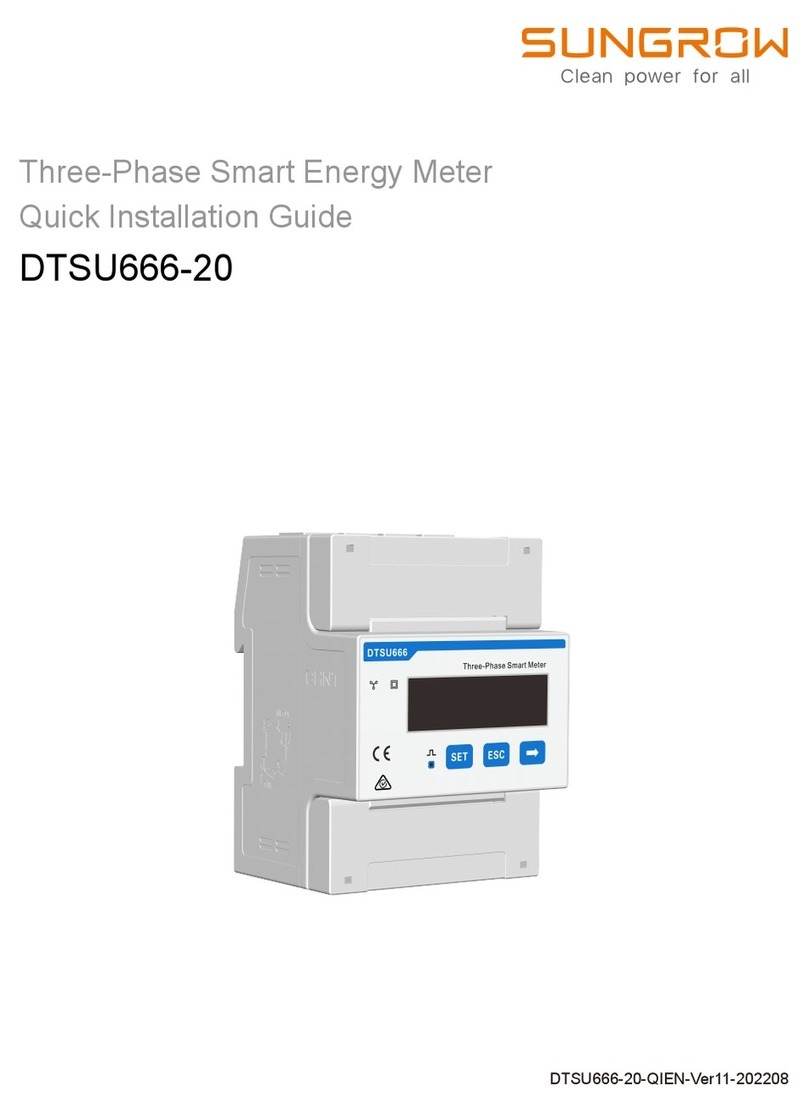
Sungrow
Sungrow DTSU666-20 Quick installation guide
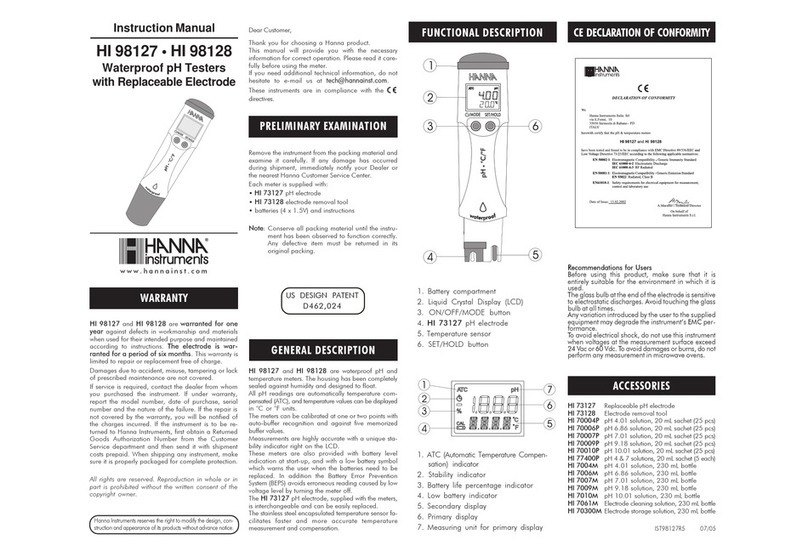
Hanna Instruments
Hanna Instruments HI 98127 instruction manual

Rosemount
Rosemount 1195 quick start guide
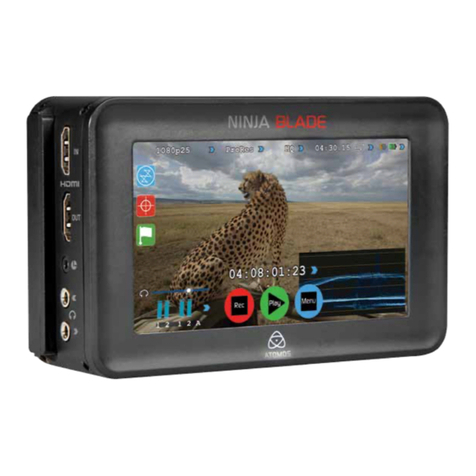
Atomos
Atomos Ninja Blade quick start guide
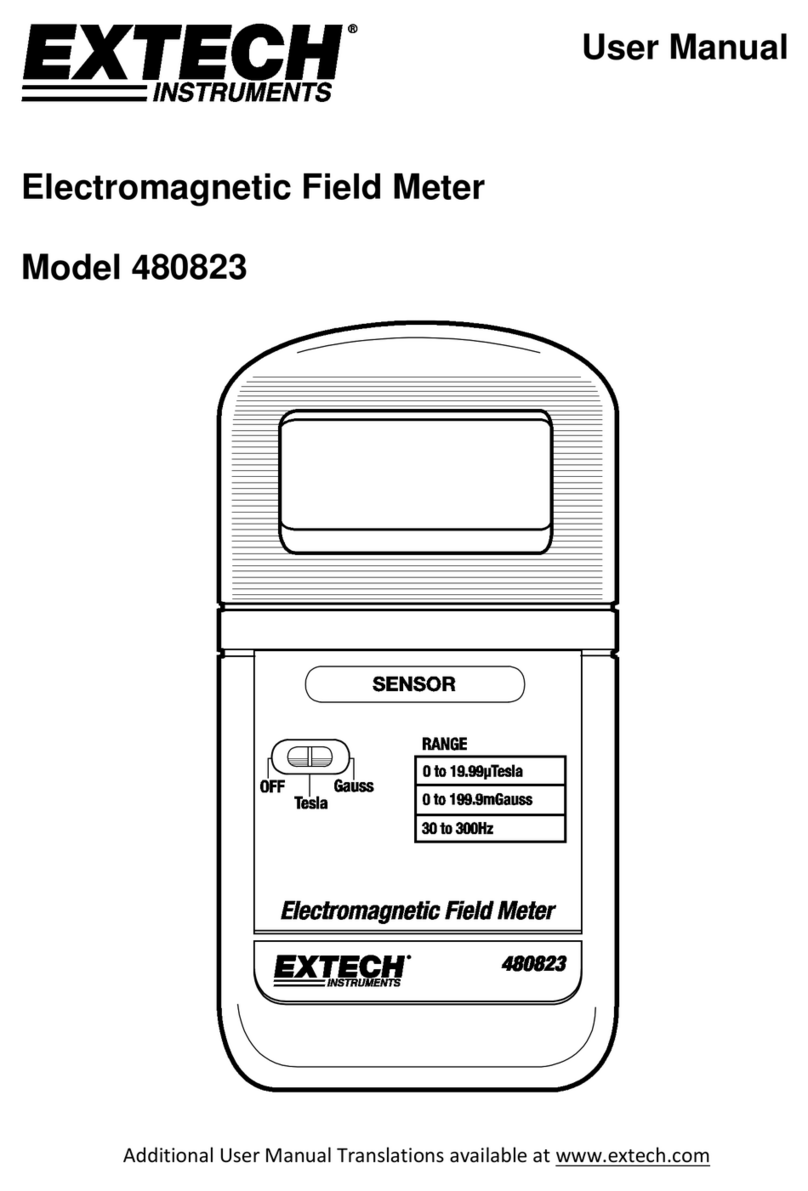
Extech Instruments
Extech Instruments 480823 user manual
